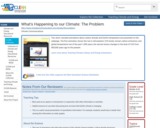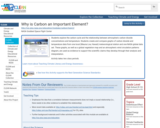
Students are introduced to the concepts of air pollution and air quality. The three lesson parts focus on the prerequisites for understanding air pollution. First, students use M&Ms to create a pie graph that expresses their understanding of the composition of air. Next, students watch and conduct several simple experiments to develop an understanding of the properties of air (it has mass, it takes up space, it can move, it exerts pressure, it can do work). Finally, students develop awareness and understanding of the daily air quality using the Air Quality Index (AQI) listed in the newspaper. In an associated literacy activity, students explore the environmental history timeline.
- Subject:
- Applied Science
- Atmospheric Science
- Engineering
- Physical Science
- Material Type:
- Activity/Lab
- Lesson Plan
- Provider:
- TeachEngineering
- Provider Set:
- TeachEngineering
- Author:
- Amy Kolenbrander
- Denise W. Carlson
- Janet Yowell
- Malinda Schaefer Zarske
- Natalie Mach
- Date Added:
- 09/18/2014


